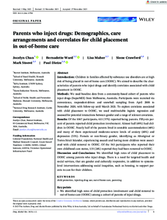Introduction
Children in families affected by substance use disorders are at high risk of being placed in out-of-home care (OOHC). The authors aimed to describe the characteristics of parents who inject drugs and identify correlates associated with child placement in OOHC.
Methods
The authors used baseline data from a community-based cohort of parents who inject drugs (SuperMIX) from Melbourne, Australia. Participants were recruited via convenience, respondent-driven and snowball sampling from April 2008 to November 2020, with follow-up until March 2021. To explore correlates associated with child placement to OOHC, the authors used multivariable logistic regression and assessed for potential interactions between gender and a range of relevant covariates.
Results
Of the 1067 participants, 611 (57%) reported being parents. Fifty-six percent of parents reported child protection involvement. Almost half (49%) had children in OOHC. Nearly half of the parents lived in unstable accommodation (44%) and many of them experienced moderate-severe levels of anxiety (48%) and depression (53%). Female or non-binary gender, identifying as Aboriginal or Torres Strait Islander, experiencing assault and having more children were associated with child removal to OOHC. Of the 563 participants who reported their own childhood care status, 135 (24%) reported they had been removed to OOHC.
Discussion and conclusions
The authors identified high rates of child placement in OOHC among parents who inject drugs. There is a need for targeted health and social services, that are gender and culturally responsive, in addition to systems-level interventions addressing social inequities, such as housing, to support parents to care for their children.

